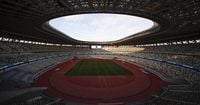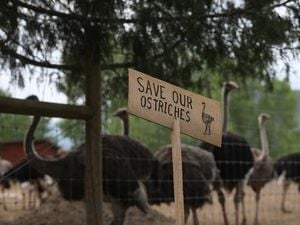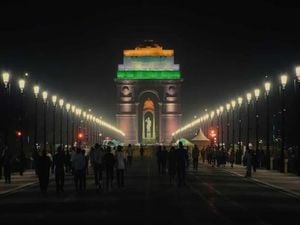Japan’s National Stadium in Tokyo, a striking symbol of modern architecture and Olympic ambition, is once again in the global spotlight as it hosts the 2025 track and field world championships. For many, this marks a moment of redemption for a venue that, just four years ago, was shrouded in silence during the pandemic-delayed Tokyo Olympics. Back then, the $1.4 billion, 60,000-seat stadium—designed by renowned architect Kengo Kuma—stood eerily empty, its grandeur muted by the absence of fans and the world’s greatest athletes competing in a vacuum.
Who could forget the quiet that enveloped the opening and closing ceremonies in 2021? Japanese Emperor Naruhito addressed the Games of the XXXII Olympiad to thousands of empty seats, a scene that felt surreal for an event built on the energy of a roaring crowd. The men’s 100-meter final, usually the centerpiece of Olympic drama, played out in near silence. Marcel Jacobs, the Texas-born Italian sprinter, crossed the finish line to claim gold, greeted only by the click of cameras and the soft shuffle of a handful of media. He draped the Italian flag across his shoulders, but the moment’s usual electricity was missing.
Fast-forward to September 13, 2025, and the stadium is finally getting the kind of attention it was built for. The world’s top track and field athletes, including American sprint sensation Noah Lyles and pole vault world-record holder Mondo Duplantis, are set to light up the venue. For fans and athletes alike, there’s a sense of anticipation—and relief. After years of limited use, the National Stadium is alive with the buzz it so desperately lacked during its Olympic debut.
But this renewed excitement also brings old questions back to the surface. Was the massive public investment in the stadium worth it? The numbers tell a sobering story. Built with taxpayer money, the National Stadium has struggled to find its footing in the years since the Olympics. With no permanent tenant and only a handful of major events each year, the stadium has been losing about 1 billion yen annually—roughly $7 million—through fiscal 2024. Even with privatization efforts aimed at easing the public burden, the national government still owns the stadium and continues to pick up some of the bills.
Victor Matheson, a sports economist at the College of the Holy Cross, put it bluntly in an email to The Associated Press: "There are simply not that many events that require a 60,000-plus capacity. There are not many music concerts that can fill a stadium that size. And things like a soccer or rugby World Cup or track and field championships only come around rarely." Matheson’s research points to a common problem with mega-stadiums worldwide. In the United States, for example, NFL stadiums typically host fewer than ten major events per year outside of football games, leaving expensive facilities largely empty most of the time.
The story of Tokyo’s National Stadium is part of a broader pattern in Olympic history. Cities like Athens (2004), Beijing (2008), and Rio de Janeiro (2016) have all wrestled with the challenge of maintaining costly venues after the Olympic flame has been extinguished. Tokyo’s situation is particularly poignant given the stadium’s troubled genesis. Original plans for a futuristic stadium by Zaha Hadid were scrapped in 2015 when projected costs soared past $2 billion. Kuma’s design, which ultimately replaced the old 1964 Olympic stadium, sought to blend seamlessly into Tokyo’s urban landscape with Japanese elements like wood, gardens, and flowing water. Yet, even with a more modest price tag, the stadium’s $1.4 billion cost is staggering—roughly equivalent to the entire 1984 Los Angeles Olympics when adjusted for inflation.
The venue’s location adds another layer of complexity. The National Stadium sits adjacent to Jingu Gaien, a cherished park-like area that includes historic baseball and rugby stadiums and an iconic avenue lined with over 100 gingko trees. But change is coming. Plans approved by the Tokyo Metropolitan Government will see the neighboring baseball and rugby stadiums razed and rebuilt, making way for three new skyscrapers in one of the city’s most valuable real estate zones. The development, spearheaded by Mitsui Fudosan and others, won’t be complete for another decade, but it’s already stirring debate about the loss of green space and the encroachment of private developers into traditionally public areas.
The 2020 Olympics, costly for taxpayers, also opened the door for these sweeping changes. As Matheson pointed out, "When someone else is footing the bill, we tend to build Rolls-Royces and not Toyota Corollas." It’s a sentiment echoed by many who question whether the benefits of such grand projects truly outweigh their long-term costs. The National Stadium, for all its architectural beauty and occasional bursts of excitement, often sits empty—an expensive reminder of the fleeting nature of Olympic glory.
Still, there’s no denying the magic of the moment when the stadium comes alive. This week, as the world’s best athletes take to the track and field, fans will finally experience the atmosphere that was so sorely missed in 2021. The roar of the crowd, the tension of competition, and the possibility of new records promise to transform the venue, if only temporarily, into the beating heart of global athletics.
Yet, the underlying issues remain. Can Tokyo’s National Stadium find a sustainable future beyond the occasional major event? Will privatization and new development in the Jingu Gaien area breathe new life into the complex, or simply shift the burden elsewhere? These are questions that linger, even as the current championships captivate audiences both in Japan and around the world.
For now, though, Tokyo’s National Stadium is enjoying a rare spotlight. The energy is palpable, the stands are full, and the world is watching. Whether this moment of glory can be parlayed into a lasting legacy is still up for debate. But for the athletes, fans, and the city itself, the return of world-class competition to this storied venue is a welcome—and long overdue—celebration.
As the track and field world championships unfold, the stadium’s fate remains a work in progress. But for nine days, at least, Tokyo’s National Stadium is exactly where it belongs: at the center of the sporting world, buzzing with life and possibility.




